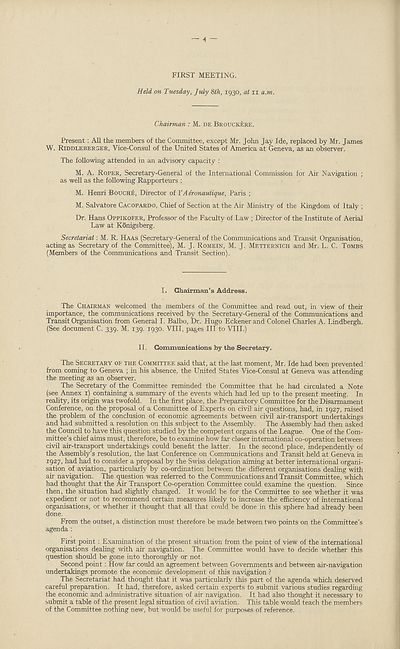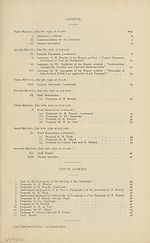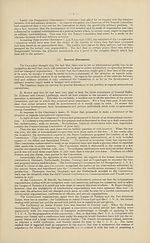Communications and transit > Air transport co-operation committee : minutes of the first session : held at Geneva from July 8th to 12th, 1930
(4)
Download files
Complete book:
Individual page:
Thumbnail gallery: Grid view | List view

— 4 ~
FIRST MEETING.
Held on Tuesday, July 8th, 1930, at 11 a.m.
Chairman : M. de Brouckere.
Present : All the members of the Committee, except Mr. John Jay Ide, replaced by Mr. James
W. Riddleberger, Vice-Consul of the United States of America at Geneva, as an observer.
The following attended in an advisory capacity :
M. A. Roper, Secretary-General of the International Commission for Air Navigation ;
as well as the following Rapporteurs :
M. Henri Bouche, Director of VAeronautique, Paris ;
M. Salvatore Cacopardo, Chief of Section at the Air Ministry of the Kingdom of Italy ;
Dr. Hans Oppikofer, Professor of the Faculty of Law ; Director of the Institute of Aerial
Law at Konigsberg.
Secretariat: M. R. Haas (Secretary-General of the Communications and Transit Organisation,
acting as Secretary of the Committee), M. J. Romein, M. J. Metternich and Mr. L. C. Tombs
(Members of the Communications and Transit Section).
I. Chairman’s Address.
The Chairman welcomed the members of the Committee and read out, in view of their
importance, the communications received by the Secretary-General of the Communications and
Transit Organisation from General I. Balbo, Dr. Hugo Eckenerand Colonel Charles A. Lindbergh.
(See document C. 339. M. 139. 1930. VIII, pages III to VIII.)
II. Communications by the Secretary.
The Secretary of the Committee said that, at the last moment, Mr. Ide had been prevented
from coming to Geneva ; in his absence, the United States Vice-Consul at Geneva was attending
the meeting as an observer.
The Secretary of the Committee reminded the Committee that he had circulated a Note
(see Annex 1) containing a summary of the events which had led up to the present meeting. In
reality, its origin was twofold. In the first place, the Preparatory Committee for the Disarmament
Conference, on the proposal of a Committee of Experts on civil air questions, had, in 1927, raised
the problem of the conclusion of economic agreements between civil air-transport undertakings
and had submitted a resolution on this subject to the Assembly. The Assembly had then asked
the Council to have this question studied by the competent organs of the League. One of the Com¬
mittee’s chief aims must, therefore, be to examine how far closer international co-operation between
civil air-transport undertakings could benefit the latter. In the second place, independently of
the Assembly’s resolution, the last Conference on Communications and Transit held at Geneva in
1927, had had to consider a proposal by the Swiss delegation aiming at better international organi¬
sation of aviation, particularly by co-ordination between the different organisations dealing with
air navigation. The question was referred to the Communications and Transit Committee, which
had thought that the Air Transport Co-operation Committee could examine the question. Since
then, the situation had slightly changed. It would be for the Committee to see whether it was
expedient or not to recommend certain measures likely to increase the efficiency of international
organisations, or whether it thought that all that could be done in this sphere had already been
done.
From the outset, a distinction must therefore be made between two points on the Committee’s
agenda :
First point : Examination of the present situation from the point of view of the international
organisations dealing with air navigation. The Committee would have to decide whether this
question should be gone into thoroughly or not.
Second point : How far could an agreement between Governments and between air-navigation
undertakings promote the economic development of this navigation ?
The Secretariat had thought that it was particularly this part of the agenda which deserved
careful preparation. It had, therefore, asked certain experts to submit various studies regarding
the economic and administrative situation of air navigation. It had also thought it necessary to
submit a table of the present legal situation of civil aviation. This table would teach the members
of the Committee nothing new, but would be useful for purposes of reference.
FIRST MEETING.
Held on Tuesday, July 8th, 1930, at 11 a.m.
Chairman : M. de Brouckere.
Present : All the members of the Committee, except Mr. John Jay Ide, replaced by Mr. James
W. Riddleberger, Vice-Consul of the United States of America at Geneva, as an observer.
The following attended in an advisory capacity :
M. A. Roper, Secretary-General of the International Commission for Air Navigation ;
as well as the following Rapporteurs :
M. Henri Bouche, Director of VAeronautique, Paris ;
M. Salvatore Cacopardo, Chief of Section at the Air Ministry of the Kingdom of Italy ;
Dr. Hans Oppikofer, Professor of the Faculty of Law ; Director of the Institute of Aerial
Law at Konigsberg.
Secretariat: M. R. Haas (Secretary-General of the Communications and Transit Organisation,
acting as Secretary of the Committee), M. J. Romein, M. J. Metternich and Mr. L. C. Tombs
(Members of the Communications and Transit Section).
I. Chairman’s Address.
The Chairman welcomed the members of the Committee and read out, in view of their
importance, the communications received by the Secretary-General of the Communications and
Transit Organisation from General I. Balbo, Dr. Hugo Eckenerand Colonel Charles A. Lindbergh.
(See document C. 339. M. 139. 1930. VIII, pages III to VIII.)
II. Communications by the Secretary.
The Secretary of the Committee said that, at the last moment, Mr. Ide had been prevented
from coming to Geneva ; in his absence, the United States Vice-Consul at Geneva was attending
the meeting as an observer.
The Secretary of the Committee reminded the Committee that he had circulated a Note
(see Annex 1) containing a summary of the events which had led up to the present meeting. In
reality, its origin was twofold. In the first place, the Preparatory Committee for the Disarmament
Conference, on the proposal of a Committee of Experts on civil air questions, had, in 1927, raised
the problem of the conclusion of economic agreements between civil air-transport undertakings
and had submitted a resolution on this subject to the Assembly. The Assembly had then asked
the Council to have this question studied by the competent organs of the League. One of the Com¬
mittee’s chief aims must, therefore, be to examine how far closer international co-operation between
civil air-transport undertakings could benefit the latter. In the second place, independently of
the Assembly’s resolution, the last Conference on Communications and Transit held at Geneva in
1927, had had to consider a proposal by the Swiss delegation aiming at better international organi¬
sation of aviation, particularly by co-ordination between the different organisations dealing with
air navigation. The question was referred to the Communications and Transit Committee, which
had thought that the Air Transport Co-operation Committee could examine the question. Since
then, the situation had slightly changed. It would be for the Committee to see whether it was
expedient or not to recommend certain measures likely to increase the efficiency of international
organisations, or whether it thought that all that could be done in this sphere had already been
done.
From the outset, a distinction must therefore be made between two points on the Committee’s
agenda :
First point : Examination of the present situation from the point of view of the international
organisations dealing with air navigation. The Committee would have to decide whether this
question should be gone into thoroughly or not.
Second point : How far could an agreement between Governments and between air-navigation
undertakings promote the economic development of this navigation ?
The Secretariat had thought that it was particularly this part of the agenda which deserved
careful preparation. It had, therefore, asked certain experts to submit various studies regarding
the economic and administrative situation of air navigation. It had also thought it necessary to
submit a table of the present legal situation of civil aviation. This table would teach the members
of the Committee nothing new, but would be useful for purposes of reference.
Set display mode to:
![]() Universal Viewer |
Universal Viewer | ![]() Mirador |
Large image | Transcription
Mirador |
Large image | Transcription
Images and transcriptions on this page, including medium image downloads, may be used under the Creative Commons Attribution 4.0 International Licence unless otherwise stated. ![]()
| League of Nations > Communications and transit > Air transport co-operation committee : minutes of the first session : held at Geneva from July 8th to 12th, 1930 > (4) |
|---|
| Permanent URL | https://digital.nls.uk/194043399 |
|---|
| Shelfmark | LN.VIII |
|---|
| Description | Over 1,200 documents from the non-political organs of the League of Nations that dealt with health, disarmament, economic and financial matters for the duration of the League (1919-1945). Also online are statistical bulletins, essential facts, and an overview of the League by the first Secretary General, Sir Eric Drummond. These items are part of the Official Publications collection at the National Library of Scotland. |
|---|---|
| Additional NLS resources: |
|

